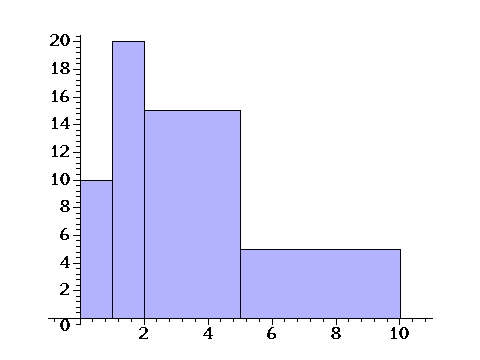Histograms don't need a vertical scaleA vertical scale is often provided to help finding %s of areasIn a histogram the hight of a block represents CROWDING -- % per horizontal unitDENSITY SCALE = % / hor.unitwith the DENSITY SCALE, areas come out in %sAREA (%) = WIDTH (hor.unit) * HIGHT ( % / hor.unit )Notice that hor.unit's cancel out.Find the HIGHT of a block withHIGHT = (AREA %) / (WIDTH hor.unit)Consider the following example:A histogram of wages for part-time employees is shown below with the hights of the blocks (in the density scale) marked in parenthesis. Nobody earned more than $1,000 a month. The block from $200 to $500 is missing.How tall should the missing block be? |
> ANSWER:
The hights of the blocks are given in the DENSITY SCALE of % per $100. Hence, the areas of the blocks come out in %s.The areas of the first two blocks are then: 10% and 20% resp.The area of the last block is:5 ($100) * 5(%/$100) = 25 %The 3 blocks together give (10+20+25)% = 55 %The missing block must have an area of (100% - 55%) = 45%The HIGHT of the missing block is then:HIGHT = 45% / (3 $100) = 15 (%/$100) |